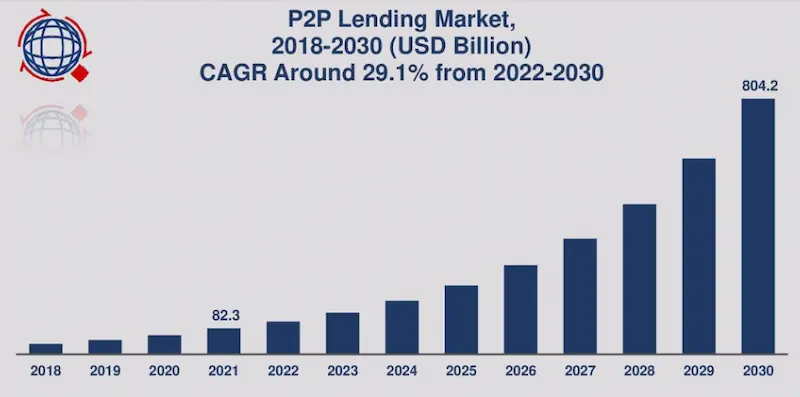Borrowers and investors are connected via peer-to-peer lending.
Borrowers seek loans using peer lending sites and peer platforms, while investors choose loans that seem to be low-risk. An investor may finance all or part of a peer loan or many loans. Many investors may be willing to lend money to individuals using these online platforms.
It’s a brand-new perspective on borrowing and lending. Borrowers may be able to get cash more quickly if conventional financial institutions such as banks are eliminated. Investors might also see a healthier return.
We’ll examine peer-to-peer lending systems and their operation on online lending platforms.
What Is Peer-To-Peer Lending?
Peer-to-peer lending, or P2P lending, is a kind of internet lending in which investors lend loans (or parts of loans) to individual borrowers through online platforms. Peer-to-peer lending, often called marketplace lending, is a kind of alternative financing to conventional loans, connecting these potential borrowers directly with willing investors.
Peer-to-peer lending services may be a viable alternative to credit unions, traditional lenders, payday loans, or credit cards for certain people. This lending system can be beneficial for both lenders and borrowers. Some borrowers may be able to find personal loans that other lenders have denied them.
Your credit score may qualify you for a low-interest-rate loan. However, those with poorer credit scores will almost certainly face higher interest rates – often much higher than the average credit card annual percentage rate. Business loans and loan request approval may also depend on factors like unsecured loans, credit reports, and minimum credit scores.
Despite the danger, investors in P2P lending may get a higher return on their money than they would with some traditional savings and investment choices.
Additionally, loan platforms may assist small company owners. According to the US Small Business Administration, U.S. Peer-to-peer lending might be feasible for small businesses seeking funding.
How Does Peer-To-Peer Lending Work?
For peer-to-peer lending, online software links prospective loan applicants with lenders. While features vary from platform to platform, many commonalities exist. Peer-to-peer lenders include Prosper, LendingClub, Peerform, and Funding Circle.
If You Need To Borrow Money, Here’s How It Works
- Completing an application, which may involve a credit check, is required. This helps determine the types of loans available, such as Secured and equity.
- Examine the interest rate if you’ve been accepted. If you choose, you may go on to the fundraising step. This option lets you explore alternatives to a traditional bank loan based on your unique financial situation.
- Allow investors to see the loan listing before deciding whether to finance it.
- After your loan has been approved, you may begin the repayment process. You will make monthly payments during the length of your loan. Your payments will be shared with the lenders. They each get a percentage of your money.
If You Are Looking To Lend Money, Here’s How It Works
- Check out the loan options. Register on the P2P lending platform that interests you.
- GreendayOnline will assign loans a grade to help you assess their risk. Auto loans and student loans are also possible. Loan applications can be completed online.
- You can keep track of all earnings and loan proceeds through your online account.
What Are The Fees Charged By P2P Lenders?
There are fees for both lenders and borrowers on P2P lending platforms. Before you sign up for a loan or give your money away, be sure you understand the conditions.
GreendayOnline charges an investment fee of approximately 1% of the total amount received during the grace period or before the payment due date.
If you’re a borrower, you could have to pay a cost called Loan origination fees.
What Are The Best Uses of a P2P Loan?
Many peer-to-peer platforms offer unsecured personal loans. You may put the money towards practically anything you choose, including traditional loans or those catering to individuals with bad credit. However, most lending platforms require you to specify the purpose of the loan.
GreendayOnline says the most popular reasons for borrowing money are debt consolidation, major purchases, home improvements, medical expenses, and mortgage repayments. GreendayOnline states that individual loan funds cannot be used to invest, pay for higher education, gamble, or any other illegal purpose. The funds are usually available within a business day.
Check out our selections for the four finest peer-to-peer personal loan lenders.
Is Peer-to-Peer Lending Safe?
Peer-to-peer lending may seem attractive — there are positive returns without the involvement of a bank. The credit inquiry process and considering the income ratio are essential when applying for a loan.
The FDIC may not insure your P2P investments. You could lose your loan if the borrower stops paying you through a P2P platform. Always provide proof of income and keep track of your medical bills for a smoother process.
Below are some statistics on Peer-To-Peer Lending:
| Statistic | Value |
|---|---|
| Global P2P lending market size | $1.2 trillion (estimated by 2025) |
| Largest P2P lending market | United States (over $50 billion in loans originated in 2021) |
| Average P2P loan interest rate | 10% |
| Average P2P loan term | 3 years |
| P2P loan default rate | about 5% |

What’s Next?
Be careful to browse and compare conditions before selecting if a loan from a peer-to-peer lender is good for you. Before choosing a loan, it is essential to consider term lengths and ensure they suit your needs. Ask yourself some questions.
- Is it possible to repay the loan? Can I repay it?
- Can I find a better rate elsewhere?
- What is the time it will take to repay the loan? Is there a prepayment penalty?
These questions will help determine whether you are financially ready to borrow or use a P2P lending platform.
Frequently Asked Questions
What is peer-to-peer lending, and how does it work?
Peer-to-peer lending connects individual investors directly with borrowers through an online platform without a traditional bank intermediary. Investors fund loan amounts requested by borrowers and receive principal and interest payments over the repayment term. The P2P platform handles verifying borrower identity and creditworthiness, facilitating payments, and collecting and distributing interest.
What are the key advantages of using peer-to-peer lending platforms?
Key advantages are improved rates and terms for borrowers versus traditional financing, attractive returns for investors, more flexibility in loan criteria leading to expanded access to capital, faster funding and originations, and often lower overhead costs passed to borrowers and investors due to disintermediation of banks. Automation also allows greater efficiency.
Are there any risks associated with participating in peer-to-peer lending as an investor or borrower?
Yes, risks exist for both sides including potential default losses for investors and privacy concerns for borrowers. Lack of regulatory oversight also poses risks. Investors face illiquidity in tying up money in multi-year loans. For borrowers, loan denial and high origination fees can be pitfalls. Performing due diligence on the specific P2P platforms is key.
How do peer-to-peer lending platforms differ from traditional banks and lending institutions?
P2P platforms connect individual investors and borrowers directly with no financial institution acting as intermediary. This disintermediation provides more favorable rates and flexibility but also less oversight. There are faster approval times, expanded access to capital for more borrowers, and often increased risk of default. Loan services are handled via automated online systems versus in-person banking.
What are some successful examples or platforms in the peer-to-peer lending industry, and how have they impacted the financial landscape?
Successful P2P lending platforms include LendingClub, Prosper, Funding Circle, Upstart, and SoFi. They have enabled expanded access to affordable credit for borrowers frozen out by banks and attractive returns for small investors. Automation and lower overhead costs provide lean operations. Though still a small fraction of the lending market, P2P continues to disrupt traditional financing models.

